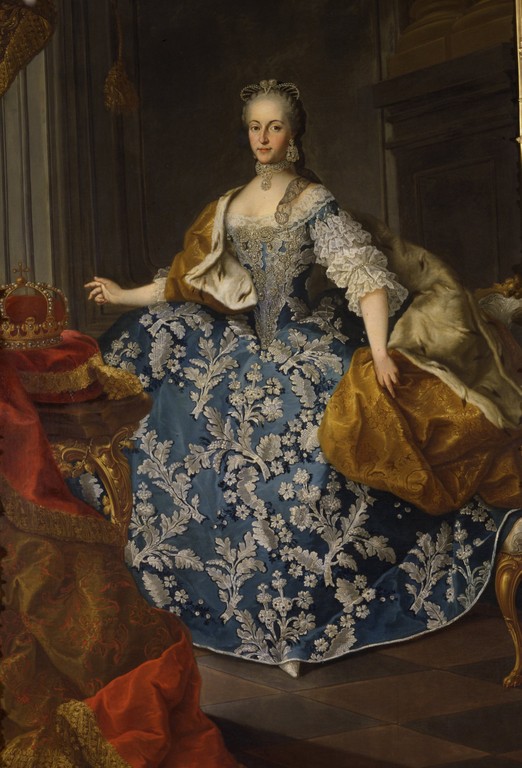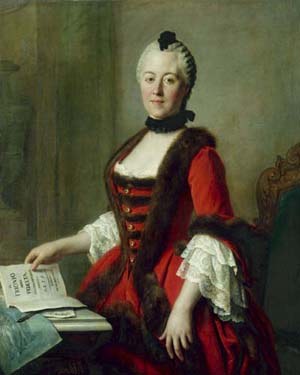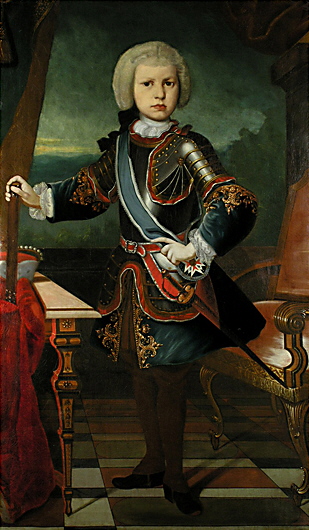|
Maria Josepha Of Bavaria
Maria Josepha Antonia Walburga Felicitas Regula of Bavaria (20 March 173928 May 1767) was Holy Roman Empress, Queen of the Romans, Archduchess of Austria, Grand Duchess of Tuscany, among other titles, by her marriage to Joseph II, Holy Roman Emperor. By birth, she was a Princess and Duchess of Bavaria as the daughter of Charles VII, Holy Roman Emperor, Elector of Bavaria, and Archduchess Maria Amalia of Austria. Family A member of the House of Wittelsbach, she was born in Munich, Bavaria. Maria Josepha was the seventh and youngest child of Charles Albert, Elector of Bavaria, and Holy Roman Emperor. Her mother, Maria Amalia, was an Archduchess of Austria by birth. Her maternal grandparents were Joseph I, Holy Roman Emperor, and Wilhelmina Amalia of Brunswick-Lüneburg. Her paternal grandparents were Maximilian II Emanuel, Elector of Bavaria, and Theresa Kunegunda Sobieska, the daughter of the King of Polish–Lithuanian Commonwealth, John III Sobieski. Josepha's mother, Arc ... [...More Info...] [...Related Items...] OR: [Wikipedia] [Google] [Baidu] |
Holy Roman Empress
The Holy Roman Empress or Empress of the Holy Roman Empire (''Kaiserin des Heiligen Römischen Reiches'') was the wife or widow of the Holy Roman Emperor. The elective dignity of Holy Roman emperor was restricted to males only, but some empresses, such as Theophanu and Maria Theresa, were ''de facto'' rulers of the Empire. Holy Roman empresses Before 924, the title of emperor was not always associated with the German Kingdom; rather, it was initially associated with the Carolingian dynasty, and then possessed by several other figures of the 9th and 10th centuries. Their wives were thus empresses, but not necessarily German queens. Carolingian Holy Roman Empresses/Queens of Germany With the elevation of Otto I of Germany in 962 to the Imperial title, the title 'Roman King/Emperor' became inalienably associated with the Kingdom of Germany – although a King of Germany might not bear the Imperial title, it would be impossible to become a Holy Roman Emperor, without being King of ... [...More Info...] [...Related Items...] OR: [Wikipedia] [Google] [Baidu] |
Archduchess
Archduke (feminine: Archduchess; German: ''Erzherzog'', feminine form: ''Erzherzogin'') was the title borne from 1358 by the Habsburg rulers of the Archduchy of Austria, and later by all senior members of that dynasty. It denotes a rank within the former Holy Roman Empire (962–1806), which was below that of Emperor and King, roughly equal to Grand Duke, but above that of a Prince and Duke. The territory ruled by an Archduke or Archduchess was called an Archduchy. All remaining Archduchies ceased to exist in 1918. The current head of the House of Habsburg is Karl von Habsburg. Terminology The English word is first recorded in 1530, derived from Middle French ', a 15th-century derivation from Medieval Latin ', from Latin ''-'' (Greek ) meaning "authority" or "primary" (see '' arch-'') and ' "duke" (literally "leader"). "Archduke" (german: Erzherzog; nl, Aartshertog) is a title distinct from "Grand Duke" (french: Grand-Duc; lb, Groussherzog; german: Großherzog; nl, Groother ... [...More Info...] [...Related Items...] OR: [Wikipedia] [Google] [Baidu] |
Second Cousin
Most generally, in the lineal kinship system used in the English-speaking world, a cousin is a type of familial relationship in which two relatives are two or more familial generations away from their most recent common ancestor. Commonly, "cousin" refers to a first cousin – a relative of the same generation whose most recent common ancestor with the subject is a grandparent. Degrees and removals are separate measures used to more precisely describe the relationship between cousins. ''Degree'' measures the separation, in generations, from the most recent common ancestor(s) to a parent of one of the cousins (whichever is closest), while ''removal'' measures the difference in generations between the cousins themselves, relative to their most recent common ancestor(s). To illustrate usage, a second cousin is a cousin with a ''degree'' of two; there are three (not two) generations from the common ancestor(s). When the degree is not specified, first cousin is assumed. A cousin ... [...More Info...] [...Related Items...] OR: [Wikipedia] [Google] [Baidu] |
Proxy Marriage
A proxy wedding or proxy marriage is a wedding in which one or both of the individuals being united are not physically present, usually being represented instead by other persons. If both partners are absent a double proxy wedding occurs. Marriage by proxy is usually resorted to either when a couple wish to marry but one or both partners cannot attend for reasons such as military service, imprisonment, or travel restrictions; or when a couple lives in a jurisdiction in which they cannot legally marry. In most jurisdictions, both parties to a marriage must be physically present, and proxy weddings are not recognized as legally binding. Under the English common law, however, if a proxy marriage is valid by the law of the place where the marriage was celebrated (the ''lex loci celebrationis'') then it will be recognised in England and Wales. History Starting in the Middle Ages, European monarchs and nobility sometimes married by proxy. Some examples of this include: * Henry IV of ... [...More Info...] [...Related Items...] OR: [Wikipedia] [Google] [Baidu] |
Maria Josepha Of Bavaria, Holy Roman Empress By Martin Van Meytens
Maria may refer to: People * Mary, mother of Jesus * Maria (given name), a popular given name in many languages Place names Extraterrestrial *170 Maria, a Main belt S-type asteroid discovered in 1877 *Lunar maria (plural of ''mare''), large, dark basaltic plains on Earth's Moon Terrestrial *Maria, Maevatanana, Madagascar *Maria, Quebec, Canada * Maria, Siquijor, the Philippines *María, Spain, in Andalusia *Îles Maria, French Polynesia *María de Huerva, Aragon, Spain *Villa Maria (other) Arts, entertainment, and media Films * ''Maria'' (1947 film), Swedish film * ''Maria'' (1975 film), Swedish film * ''Maria'' (2003 film), Romanian film * ''Maria'' (2019 film), Filipino film * ''Maria'' (2021 film), Canadian film directed by Alec Pronovost * ''Maria'' (Sinhala film), Sri Lankan upcoming film Literature * ''María'' (novel), an 1867 novel by Jorge Isaacs * ''Maria'' (Ukrainian novel), a 1934 novel by the Ukrainian writer Ulas Samchuk * ''Maria'' (play), a 1935 play ... [...More Info...] [...Related Items...] OR: [Wikipedia] [Google] [Baidu] |
Maria Anna Josepha Of Bavaria
Maria Anna Josepha of Bavaria (''Maria Anna Josepha Augusta''; 7 August 1734 – 7 May 1776) was a Duchess of Bavaria by birth and Margravine of Baden-Baden by marriage. She was nicknamed the ''savior of Bavaria''. She is also known as ''Maria Josepha'' and is sometimes styled as a ''princess of Bavaria''. Biography Maria Anna Josepha was born at the Nymphenburg Palace in 1734. She was the fifth child of Charles Albert, Elector of Bavaria (later Holy Roman Emperor) and his wife Maria Amalia of Austria. She was baptised with the names ''Maria Anna Josepha Augusta''. A member of the House of Wittelsbach, rulers of the Electorate of Bavaria, she was styled a Duchess of Bavaria. She married Louis George of Baden-Baden, the ruling Margrave of Baden-Baden and son of the late Louis William of Baden-Baden and his wife Sibylle of Saxe-Lauenburg, the latter was the regent of Baden-Baden for the infant Louis George. The couple were married at the Schloss Ettlingen in Baden on 20 ... [...More Info...] [...Related Items...] OR: [Wikipedia] [Google] [Baidu] |
Duchess Maria Antonia Of Bavaria
Maria Antonia, Princess of Bavaria, Electress of Saxony (18 July 1724 – 23 April 1780) was a German princess, composer, singer, harpsichordist and patron of the arts, known particularly for her operas: ''Il trionfo della fedeltà'' (“The triumph of fidelity”) and ''Talestri, regina delle amazoni'' (“Talestri, queen of the Amazons”). She was Electress of Saxony as the wife of Frederick Christian, Elector of Saxony. Following the latter's death in 1763, she became the Regent of Saxony for their son Frederick Augustus I of Saxony. Family and background Baptized ''Maria Antoina Walpurgis Symphorosa'', she was born at Nymphenburg Palace in Munich to Archduchess Maria Amalia of Austria and Elector Karl Albert of Bavaria. Throughout her life she received an outstanding education, particularly in the arts; including that of painting and writing poetry, as well as music. She was the fourth of seven children of the Elector and his wife. Marriage A marriage by proxy to ... [...More Info...] [...Related Items...] OR: [Wikipedia] [Google] [Baidu] |
Maximilian III, Elector Of Bavaria
Maximilian III Joseph, "the much beloved", (28 March 1727 – 30 December 1777) was a Prince-elector of the Holy Roman Empire and Duke of Bavaria from 1745 to 1777. Biography Born in Munich, Maximilian was the eldest son of Holy Roman Emperor Charles VII and his wife, Maria Amalia of Austria, daughter of Holy Roman Emperor Joseph I. Upon his father's death in January 1745, he inherited a country in the process of being invaded by Austrian armies (see War of the Austrian Succession). The 18-year-old Maximilian Joseph wavered between the ''Peace-party'', led by his mother Maria Amalia and Army Commander Friedrich Heinrich von Seckendorff and the ''War-party'', led by Foreign Minister General Ignaz Count of Törring and the French envoy Chavigny. After the decisive defeat in the Battle of Pfaffenhofen on 15 April Maximilian Joseph quickly abandoned his father's imperial pretenses and made peace with Maria Theresa in the Treaty of Füssen, in which he agreed to support her husb ... [...More Info...] [...Related Items...] OR: [Wikipedia] [Google] [Baidu] |
Maria Theresa
Maria Theresa Walburga Amalia Christina (german: Maria Theresia; 13 May 1717 – 29 November 1780) was ruler of the Habsburg dominions from 1740 until her death in 1780, and the only woman to hold the position ''suo jure'' (in her own right). She was the sovereign of Austria, Hungary, Croatia, Bohemia, Transylvania, Mantua, Milan, Lodomeria and Galicia, the Austrian Netherlands, and Parma. By marriage, she was Duchess of Lorraine, Grand Duchess of Tuscany and Holy Roman Empress. Maria Theresa started her 40-year reign when her father, Emperor Charles VI, died on 20 October 1740. Charles VI paved the way for her accession with the Pragmatic Sanction of 1713 and spent his entire reign securing it. He neglected the advice of Prince Eugene of Savoy, who believed that a strong military and a rich treasury were more important than mere signatures. Eventually, Charles VI left behind a weakened and impoverished state, particularly due to the War of the Polish Succession and the Rus ... [...More Info...] [...Related Items...] OR: [Wikipedia] [Google] [Baidu] |
John III Sobieski
John III Sobieski ( pl, Jan III Sobieski; lt, Jonas III Sobieskis; la, Ioannes III Sobiscius; 17 August 1629 – 17 June 1696) was King of Poland and Grand Duke of Lithuania from 1674 until his death in 1696. Born into Polish nobility, Sobieski was educated at the Jagiellonian University and toured Europe in his youth. As a soldier and later commander, he fought in the Khmelnytsky Uprising, the Russo-Polish War and during the Swedish invasion known as the Deluge. Sobieski demonstrated his military prowess during the war against the Ottoman Empire and established himself as a leading figure in Poland and Lithuania. In 1674, he was elected monarch of the Polish–Lithuanian Commonwealth following the sudden and unexpected death of King Michael. Sobieski's 22-year reign marked a period of the Commonwealth's stabilization, much needed after the turmoil of previous conflicts. Popular among his subjects, he was an able military leader, most famous for his victory over the Turks ... [...More Info...] [...Related Items...] OR: [Wikipedia] [Google] [Baidu] |
Theresa Kunegunda Sobieska
Theresa Kunegunda ( pl, Teresa Kunegunda Sobieska, german: Kurfürstin Therese Kunigunde) (4 March 1676 – 10 March 1730) was a Polish princess, Electress of Bavaria and of the Electorate of the Palatinate. By birth she was member of the House of Sobieski and by marriage member of the House of Wittelsbach. She also served as Regent of the Palatinate in 1704–05. Biography She was a daughter of the King of Poland and Grand Duke of Lithuania John III Sobieski and his wife, Marie Casimire Louise de La Grange d'Arquien. While her parents had thirteen children she was the only daughter to survive childhood. Theresa was baptized in Jaworow on 19 July 1676, having for her godfather Charles II, king of England and for her godmother Marie-Thérèse of Austria, wife of Louis XIV. Theresa was educated in painting and music, Latin, Italian and French. At the beginning of 1692, her father planned to marry her to the Prince of Denmark, but this project was subsequently abandoned. Weddin ... [...More Info...] [...Related Items...] OR: [Wikipedia] [Google] [Baidu] |
Maximilian II Emanuel
Maximilian, Maximillian or Maximiliaan (Maximilien in French) is a male given name. The name " Max" is considered a shortening of "Maximilian" as well as of several other names. List of people Monarchs *Maximilian I, Holy Roman Emperor (1459–1519) *Maximilian II, Holy Roman Emperor (1527–1576) *Maximilian I, Elector of Bavaria (1573–1651) *Maximilian II Emanuel, Elector of Bavaria (1662–1726) *Maximilian III Joseph, Elector of Bavaria (1727–1777) *Maximilian I Joseph of Bavaria (1756–1825) *Maximilian II of Bavaria (1811–1864) *Prince Maximilian of Baden (1867–1929) *Duke Maximilian Joseph in Bavaria (1808–1888) * Maximilian I of Mexico (1832–1867) Other royalty *Maximilian, Hereditary Prince of Saxony (1759–1838) *Maximilian, Margrave of Baden (born 1933) Saints *Maximilian of Antioch (died ), Christian martyr *Maximilian of Lorch (died 288), Christian bishop and martyr *Maximilian of Tebessa (274–295), Christian martyr *Maximilian Kolbe (1894–1941), ... [...More Info...] [...Related Items...] OR: [Wikipedia] [Google] [Baidu] |

.jpg)





